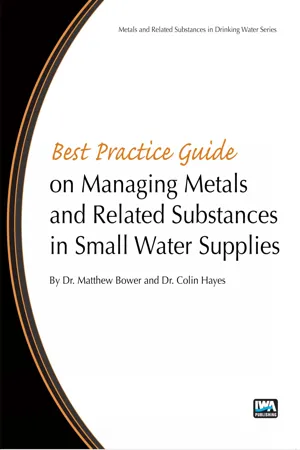
Best Practice Guide on the Management of Metals in Small Water Supplies
- 148 pages
- English
- PDF
- Available on iOS & Android
Best Practice Guide on the Management of Metals in Small Water Supplies
About This Book
The management of small water supplies presents a unique challenge globally, in countries at all stages of development. A combination of lack of resources, limited understanding of the risks and poor expertise means that individuals and communities may face serious health risks from these supplies. This is not only due to microbiological contamination, but also from contamination by metals, either due to natural or man-made contamination of the source water or through leaching from plumbing materials due to inadequate conditioning and corrosion inhibition and use of inappropriate materials.
This Best Practice Guide aims to share best practice and experience from around the world on a practical level. It looks at general issues relating to small supplies and ways of managing these, adopting a Water Safety Plan approach to deliver sound and lasting improvements to quality. Management techniques and treatment relating to specific metals will be covered, from a theoretical and practical perspective, to deliver a publication that will act as an authoritative guide for all those faced with the problem of ensuring the quality of a small water supply. Varied case-studies will help to illustrate issues and ways in which they have been resolved.
Table of contents
The Difficulties of Managing Water Quality in Small WaterSupplies; What are Small Supplies?; The Management and Regulation of SmallWater Supplies; The Vulnerability of Small Water Supplies to Contamination byMetals; Water Safety Plans for Small Water Supplies; Making WSPs Work for SmallSupplies; Teamwork- The Value of a WSP Team; APractical Guide to Developing a WSP for a Small Supply; Practical Guidance for Risk Assessments; Establishing the MetalsProblem: Risk Assessment, Sampling and Analysis; The Range of PossibleProblems; Metal Solubility and Influencing Factors; Risk Assessment of SmallWater Supply Systems; Sampling and Analysis; Consumer Awareness; Sources ofMetals in Small Water Supplies; Origin of Contaminants; Contamination ofSurface Waters; Contamination of Ground Water; Contamination from TreatmentProcesses; Contamination in Distribution Pipework; Contamination from PlumbingFittings; Water Treatment Processes Available for Use on Small Water Systems;Process Selection; Types of Treatment; Practical Considerations of Treatmentfor Metals in Small Water Supplies; Iron; Manganese; Conditioning of Water toPrevent Dissolution of Plumbing Materials or Post-treatment Contamination; Treatmentis Only Part of the Story; Indications and Effects of Post-treatment Metal Contamination in Small WaterSupplies; Establishing the Source of the Problem; Factors Controlling theCorrosion of Metals into Small Water Supplies; The Conditioning of Water toMinimise Corrosion; Manual of Individual Metals in Small Water Supplies, Aluminium, Antimony, Arsenic, Barium, Beryllium, Boron, Cadmium, Chromium, Cobalt, Copper, Iron, Lead, Manganese, Mercury, Nickel, Selenium, Tin, Tungsten, Uranium, Vanadium, Zinc; Case Studies; Arsenic removal in Small Supplies in Italy; A New BoreholeSupply with Iron Removal for a Single Property in England, UK; Metals in SmallWater Supplies in Areas of Water Scarcity in African Regions; Unexplained LeadContamination of a Small Water Supply in Northern Scotland
EDITORS
Matt Bower, Drinking Water Quality Regulator for Scotland, UK
Colin Hayes, Swansea University, UK
Frequently asked questions
Information
Table of contents
- Cover
- Contents
- Authors
- Acknowledgements
- Abbreviations and Acronyms
- About this Best Practice Guide
- Foreword
- Executive Summary
- Chapter 1: The difficulties of managing water quality in small water supplies
- Chapter 2: Water safety plans for small water supplies
- Chapter 3: Establishing the metals problem: Risk assessment, sampling and analysis
- Chapter 4: Sources of metals in small water supplies
- Chapter 5: Water treatment processes available for use on small water supplies
- Chapter 6: Practical considerations of treatment for iron and manganese in small water supplies
- Chapter 7: Conditioning water to prevent dissolution of plumbing materials or post-treatment contamination
- Chapter 8: Manual of individual metals – occurrence, implications and management
- Chapter 9: Case studies